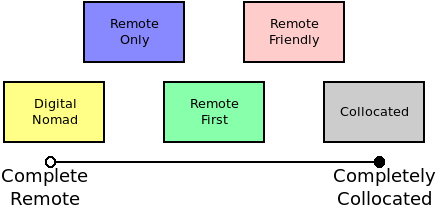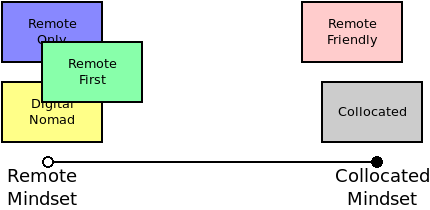Is remote work doomed to failure?
July 19, 2021
I predict that within 5 years, a majority of companies with optional work-from-home policy will be migrating back to an in-person workforce. But hope is not lost for those who are intentional about building a remote-first workplace.I’ve been a remote-work advocate for more than a decade, having worked mostly from home since 2011, and for a variety of different companies.
So with the pandemic apparently coming to a close, and many companies announcing “permanent” work-from-home policies, you might expect me to be elated.
But I’m not.
You see, I don’t actually believe these companies’ claims.
I predict that within 5 years, a majority of companies with optional work-from-home policy will be migrating back to an in-person workforce.
It’s not that I think these companies are lying. It’s that I think they don’t have any idea what they’re signing up for.
Once these companies realize that optional work-from-home isn’t good for business, they’ll change policy, in exactly the same way they adapted to mandatory work-from-home when it was necessary.
Before I make my case, though, let me provide some background.
Flavors of remote work
Not all work-from-home arrangements are created equal. You’ve probably heard terms like “remote-first” and “remote-friendly”. Lest there be any confusion about what I mean, let me define these and some other related terms.
Collocated
Employees work from a central office. Work-from-home is either completely disallowed, or allowed only on an exceptional or case-by-case basis.
Remote-Friendly
The underlying assumption is that work is collocated, but flexibility is afforded for employees to work remotely. Some employees may work from home 100% of the time, others perhaps 2 days per week, or a few weeks out of the year.
Remote-First
The underlying assumption is that work is done remotely, but flexibility is afforded for employees who wish to work in the same place. This may be done in a company-owned/leased office space, or perhaps in coworking space.
Remote-Only
Pretty self explanatory. No option to work from an office, probably because there isn’t one!
It’s common to view remote working options as existing along some sort of spectrum:

I’ve thrown “Digital Nomad” in there, as sort of the epitome of the most prototypical remote worker imaginable.
This view seems reasonable on the surface. Unfortunately, it’s almost completely wrong. In terms of daily work practices.
A more accurate representation would probably look something like this:

The reason for this disparity between the perception and reality of remote working models lies in how people work and communicate.

A day in the life of a collocated team
When we assume that most work is collocated, we optimize for a collocated workflow. We optimize for physical proximity. That includes things like watercooler conversation, whiteboards, conference rooms, after-work drinks, parties, and company off-sites.
Even with a friendly work-from-home policy, at such a company you’ll typically know that you’re missing something when you’re not in the office. Maybe you can’t see the whiteboard where some notes were made last week. Maybe your colleagues forget to include you via Zoom for the daily stand up, and decide it’s okay, because you’ll be back tomorrow.
Maybe you just miss the after-work party, and the chance to laugh with your workmates.
A day in the life of a remote team
In contrast, when we assume that most work is handled remotely, we optimize for a remote workflow. We optimize for physical distance. That includes things like online chat tools, virtual whiteboards, video conferencing, and coordinating occasional physical get-togethers for fun and off-sites.
With a remote mindset, everyone is always included (or not) in the same way. There’s no incidental privilege that comes from being in the physical office. You’ll never feel like you’re missing something because you’re not in the office—or if you are, so is everyone else, and the company as a whole needs to find a solution.
A personal example
Let me make this more concrete, with a personal example.
I spent approximately 2 years working for a “remote-friendly” company, whose office was a 2-hour flight from my home. The team I was on was very distributed, with people in North America, Eastern Europe, and Western Europe. Only one or two of the people on my direct team worked from the office, although company-wide, this was the exception, as approximately 80% of the employees were in the office.
On a team level, things worked pretty well, because the entire team was distributed. We held all meetings via video conferencing, we made heavy use of online chat tools, and wikis for documentation, etc.
However, at the company level things were very different. Despite their “remote-friendly” policy, which allowed anyone to work from home at any time, for any reason, the assumption was that most people worked from the office.
A few examples of tension I experienced from this remote-friendly but not remote-first approach:
- On more than one occasion, I’d be in a chat conversation with someone from a different team, who would say “Let me walk over to your desk, which floor are you on?”
- At one annual all-hands gathering, the “pub quiz” included questions that were only possibly answerable by people who worked in the office (e.g. “Who dressed up as evil Santa Claus at the Halloween party?”)
- The company had a generous policy of buying any book for anyone who wanted it. But there was no mechanism in place to provide books for remote employees. I had to wait until I was physically in the office to collect the books I had requested.
Individually, none of these is a serious problem. But they add up to the sense that remote employees are second-class citizens. And it’s many times worse if you’re the only remote employee on an otherwise collocated team!

But the pandemic has proven remote works!
Yes, the pandemic has proven that a remote workforce can be effective.
My fear is that most companies have not understood why. They’ve become convinced that remote working isn’t the barrier they thought it was pre-pandemic, so their minds have been opened to the possibility of remote work. However, they have not adopted an actual understanding of the magic that makes remote working possible.
Right now, by accident, these companies are forced into a remote-only mindset.
I expect that many of these companies will revert to a remote-friendly approach, as soon as it is deemed safe, and they’ll fall back into the old patterns of a collocated mindset. The friendly work-from-home policy will make people feel good for a while. But over time, problems will arise…
- The team keeps forgetting to ask Bob for his opinion on decisions, because he lives in another city.
- Those in the office routinely go for beers, and Alice, who lives just a mile away, but chose to work from home, is left out.
- Decisions are made over coffee in the break room, and no buy-in is obtained from the remote half of the team
- Zoom isn’t working today. It’s okay. We’ll send Carol the meeting notes.
- The local dev environment isn’t reliable, but people in the office aren’t motivated to maintain it because they have fast network access to the build servers.
I’ll stop here, but I hope you get the idea.
Over time, these tensions will mount. And as they do, I predict many companies will start rolling back their lenient work-from-home policies, citing the communication and logistical failures they see as associated with working from home.
Other companies will continue to operate in this broken mode for years (as some did pre-pandemic). As a result, they’ll alienate a lot of employees. Some employees won’t mind. They’ll coast beneath the radar, collecting a check, and not contributing as much as they otherwise would. Other employees will leave for companies that care enough to include them. The end result will be a special case of the Dead Sea effect.
Hope is not lost
Now having said all that, there is still hope. If these companies want remote working to be a success, it’s not actually hard. And this success can still be had, even with the use of an office. But it requires intentionally preserving the remote mindset. Here are a few examples of things I Have in mind:
- Eliminate conference rooms that hold more than, say, 4 people. This forces meetings to take place over video conferencing, even when a majority (or everyone) are in the same building.
- Avoid physical whiteboards, post-its, etc. They don’t need to be completely eliminated, but they should not be used for official records. If you do use these, take a photo, and share it electronically with everyone who needs the information.
- Use floating desks. Some companies put identical monitors, keyboards, mice, and docking stations at every desk. Employees then choose any available when they arrive, rather than claiming one as their own. This helps instill a remote mindset, even when in the same building or room.
- Reduce the number of traditional desks. Let people work in restaurant-style booths, or other less traditional “nomadic” style workplaces, to again instill a sense of a temporary workspace.
- Provide all the tools necessary for seamless remote work. This should be obvious, but sadly it seems it’s not. Remote work often requires extra hoops—such as joining a VPN.
- Move conversations into the cloud. Use wikis, chat rooms, issue trackers, and even email, in place of watercooler conversations. This has the added benefit of providing long-term documentation, even for those who are collocated.
- Be open to, and solicit feedback from everyone, but especially remote workers, about how to improve.
- Prefer asynchronous forms of communication—doubly important if your team spans time zones.
The bottom line is: For remote work to remain successful, we must be intentional about it. The default workplace assumption must be that everyone is working remotely, even when they are not.
Is your team struggling with making remote work effective? I can help. I’ve been helping teams work more effectively over vast distances and time zones for years. Get in touch, and let’s see how I can help you.



